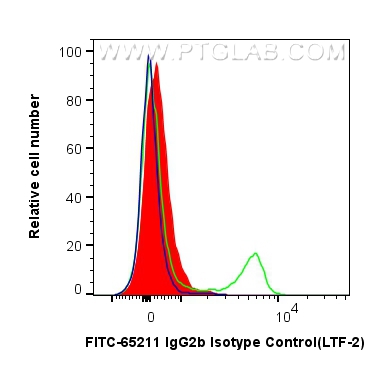验证数据展示
经过测试的应用
| Positive FC detected in |
推荐稀释比
| 应用 | 推荐稀释比 |
|---|---|
| Flow Cytometry (FC) | FC : 0.25 ug per 10^6 cells in 100 μl suspension |
| This reagent has been tested for flow cytometric analysis. It is recommended that this reagent should be titrated in each testing system to obtain optimal results. | |
| Sample-dependent, Check data in validation data gallery. | |
发表文章中的应用
| FC | See 1 publications below |
产品信息
FITC-65211 targets IgG2b Isotype Control in FC applications and shows reactivity with samples.
| 经测试应用 | FC Application Description |
| 文献引用应用 | FC |
| 经测试反应性 | |
| 免疫原 |
N/A 种属同源性预测 |
| 宿主/亚型 | Rat / IgG2b, kappa |
| 抗体类别 | Monoclonal |
| 产品类型 | Antibody |
| 全称 | IgG2b Isotype Control |
| 别名 | FITC Rat IgG2b Isotype Control, IgG2b, IgG2b Isotype Control, Rat IgG2b Isotype Control |
| 基因名称 | |
| Gene ID (NCBI) | |
| RRID | AB_2883825 |
| 偶联类型 | FITC Plus Fluorescent Dye |
| 最大激发/发射波长 | 495 nm / 524 nm |
| 形式 | Liquid |
| 纯化方式 | Affinity purification |
| 储存缓冲液 | PBS with 0.09% sodium azide, pH 7.3. |
| 储存条件 | Store at 2-8°C. Avoid exposure to light. Stable for one year after shipment. |
背景介绍
The LTF-2 immunoglobulin is useful as an isotype-matched control. The LTF-2 immunolglobulin has an unknown binding specificity and is used as an isotype control for rat IgG2b antibodies. This antibody has been quality-tested for flow cytometry as negative control.
实验方案
| Product Specific Protocols | |
|---|---|
| FC protocol for FITC Plus IgG2b Isotype Control antibody FITC-65211 | Download protocol |
| Standard Protocols | |
|---|---|
| Click here to view our Standard Protocols |


